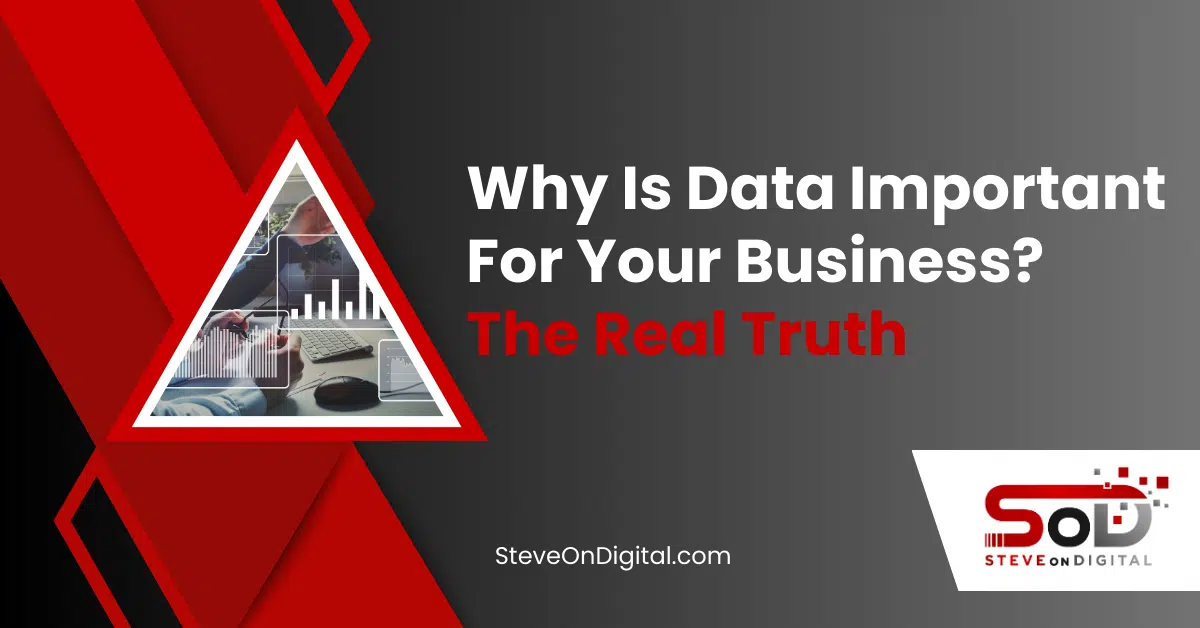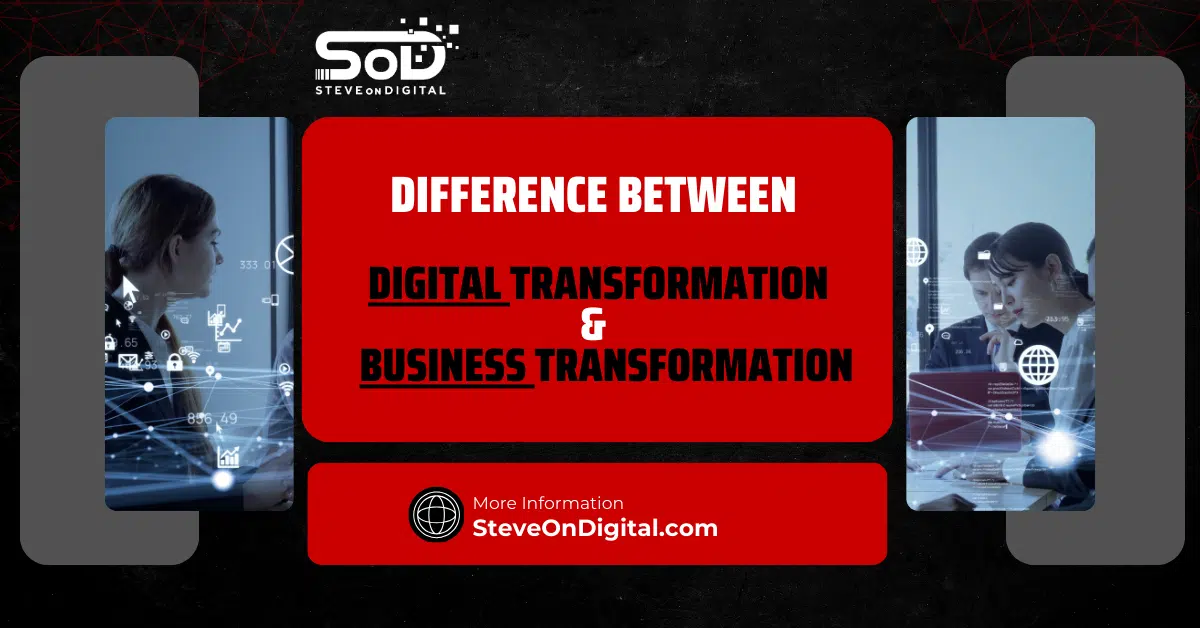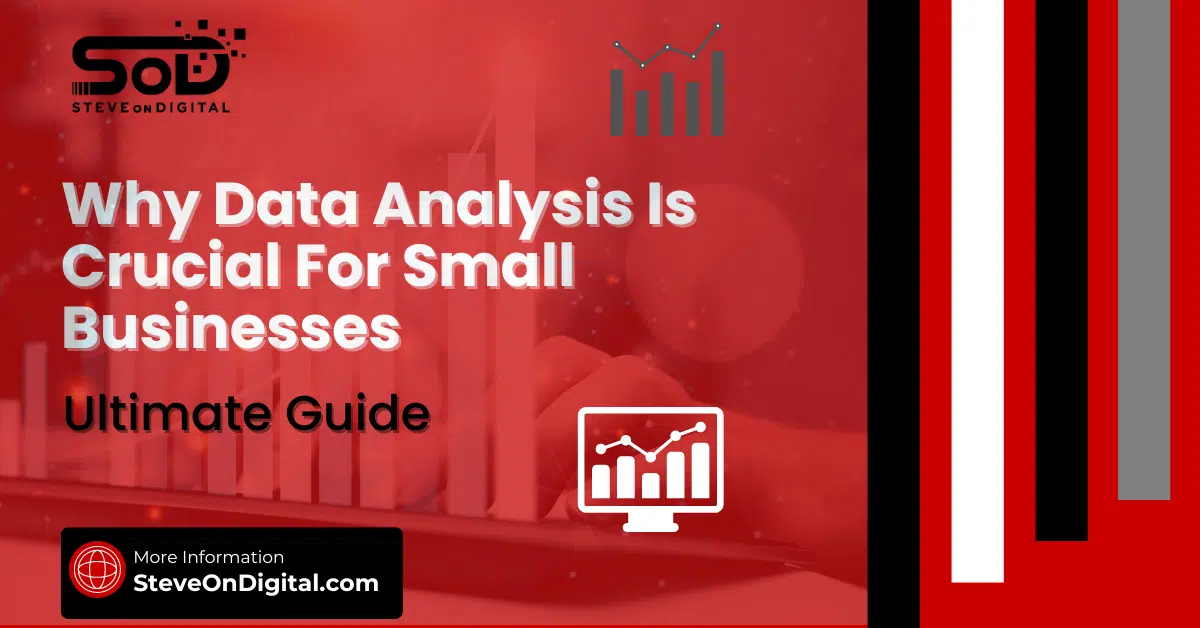Hello, I’m Steve Johnston from SteveOnDigital, and today we’re diving into why data is foundational for any business looking to thrive in today’s fast-paced market.
Across industries, data has transitioned from a nice-to-have to an absolutely essential asset.
It drives strategic decisions, refines business processes, and directly impacts the bottom line.
Through my journey as a Digital Transformation Specialist, I’ve witnessed first-hand how the power of good data transforms SMEs.
Here’s a closer look at why data is so pivotal.
Data not only provides a clear understanding of where your business stands but also unveils pathways to where it could go.
It’s about collecting data, both internal data and external data, and analyzing it to better understand your market conditions, consumer behavior, and operational efficiency.
In this post, I’ll share insights on how leveraging data can grant your business a competitive edge, make your operations more efficient, and help you make informed decisions that drive growth.
Unpacking The Value Of Customer Data
Customer data is gold in the digital economy.
Every interaction your customers have with your business, from browsing your website to completing a transaction, generates valuable data.
By analyzing customer information, such as demographic details, purchasing habits, and social media activity, businesses can gain actionable insights.
For instance, in my experience working with SMEs, I’ve helped businesses tailor marketing efforts by harnessing marketing data and customer feedback to create personalized customer experiences.
This not only boosts customer retention but also increases revenue.
One particular case involved a small retailer who, by leveraging customer data through predictive analytics, was able to optimize their stock levels and manage inventory more effectively, significantly reducing costs.
Moreover, the strategic planning of marketing campaigns becomes more targeted with access to rich customer data.
For example, understanding customer preferences helps tailor advertising retargeting, which in turn enhances the effectiveness of marketing dollars spent.
This approach not only cuts costs but also increases the efficiency of marketing efforts, ensuring that every penny counts.
Data Analysis
Data analysis acts as the backbone for strategic decision-making in any business.
With the right tools and techniques, raw data is transformed into insights that can guide key business decisions and strategies.
In my role, I often guide businesses in setting up systems to analyze data effectively, ensuring that they can respond swiftly to changing market conditions and consumer needs.
Tools like business intelligence software and data analytics platforms play a crucial role here.
They allow businesses to process large volumes of data—big data—to unearth patterns and trends that are not visible to the human eye.
This kind of analysis leads to better informed decisions, enhances business performance, and can even help in developing new business models.
For example, through data driven insights gathered from sales and customer interactions, a business can refine its product performance and make smarter decisions about which new services to launch.
In one instance, by analyzing sales data and customer feedback, a business I worked with could adjust its product offerings to better meet the needs of its consumers, significantly boosting sales and customer satisfaction.
Optimizing Business Operations Through Data-Driven Processes
In my years guiding SMEs through digital transformations, I’ve seen firsthand how data-driven processes are pivotal for streamlining operations and enhancing productivity.
Here’s how businesses can utilize data analytics to not only boost efficiency but also substantially cut costs.
- Streamlining Business Processes: By collecting data and analyzing it, businesses can identify bottlenecks and inefficiencies in their operations. For instance, data analysis can reveal excessive stock levels or underutilized resources, allowing management to make informed decisions to optimize resource allocation.
- Enhancing Productivity: Good data provides a roadmap for refining operational practices, leading to improved employee productivity. Techniques like predictive analytics can forecast workload and output levels, helping to balance workloads effectively and prevent burnout.
- Reducing Costs: Operational efficiency directly correlates with cost reduction. Data analytics aids in pinpointing areas where costs can be minimized without impacting quality. For example, by analyzing energy consumption data, companies can adjust their usage patterns to reduce utility bills significantly.
Let me share a personal example.
In one of the projects, by implementing a data-driven approach to manage inventory, we helped a client reduce overstock and avoid stockouts.
This optimization led to a 20% reduction in inventory costs, showcasing how analyzing data can lead directly to significant financial savings.
Risk Management And Security
The role of data in risk management cannot be overstated.
Data helps business owners anticipate potential risks and implement strategies to mitigate them effectively.

Here’s how data fortifies a business’s defenses:
- Identifying Potential Risks: Through data analysis, businesses can detect emerging risks before they become threats. For example, consumer data analysis can help anticipate market shifts that may pose risks to a company’s sales projections.
- Implementing Security Measures: Data analytics plays a crucial role in cybersecurity. By analyzing data patterns, companies can identify potential security breaches and address vulnerabilities promptly. This proactive approach is vital in safeguarding sensitive customer information and business operations.
From my experience, a clear understanding of risk management through data has enabled companies I’ve worked with to not just survive but thrive amid uncertainties.
By analyzing historical data and market conditions, we’ve developed strategies that shield businesses from potential financial and operational risks.
Competitive Advantage Through Strategic Data Use
In today’s rapidly changing business environment, maintaining a competitive edge is more challenging and crucial than ever.
Here’s how businesses leverage both internal data and external data to stay ahead of the competition:
- Leveraging Internal Data: Companies use internal data to optimize their offerings and operations, creating a competitive advantage. For instance, analyzing customer feedback and sales data allows businesses to fine-tune their products and services to better meet customer needs.
- Utilizing External Data: External data provides insights into industry trends and competitor strategies. By understanding these dynamics, businesses can adapt their strategies to seize opportunities and counteract competitive threats.
Leveraging Big Data And Predictive Analytics For Future Planning
In the realm of digital transformation, big data and predictive analytics have become essential tools for businesses looking to stay ahead.
As a Digital Transformation Specialist, I’ve seen these tools in action, helping businesses forecast market trends and anticipate customer needs with remarkable accuracy.
Here’s how leveraging these technologies can enhance your strategic planning and decision-making processes.
- Forecasting Market Trends: Big data allows businesses to analyze vast amounts of information from various sources, including market conditions, social media activity, and global economic indicators. By applying predictive analytics, businesses can identify trends and patterns that forecast future market movements. This enables companies to prepare and adapt strategies that align with predicted changes, ensuring they remain competitive.
- Anticipating Customer Needs: Predictive analytics utilizes historical data to predict future behaviors. By understanding past consumer behavior, businesses can predict future needs and preferences. This capability allows for the development of products and services that meet the evolving demands of customers, often before the customers themselves are aware of their own needs.
From personal experience, utilizing big data and predictive analytics in strategic planning has enabled the companies I’ve advised to not only mitigate risks but also discover lucrative opportunities for growth.
For example, a retail client used predictive models to forecast seasonal fluctuations and adjust their inventory and marketing strategies accordingly, which significantly boosted their sales and customer satisfaction.
| Benefit | Description |
| Improved Demand Forecasting | Predictive models analyze historical sales data to accurately forecast future demand and manage inventory. |
| Enhanced Customer Insights | Analyzing customer behavior patterns helps predict future buying habits and preferences. |
| Risk Reduction | Identifies potential risks in business operations and market trends, allowing for preemptive actions. |
| Operational Efficiency | Optimizes business operations by predicting peak operation times and resource requirements. |
Marketing And Sales
The impact of data on marketing and sales strategies cannot be overstated.
In today’s data-driven world, the ability to analyze customer information and marketing data has transformed how businesses approach sales and marketing.
Here’s how data-driven insights are making a significant impact:
- Enhancing Marketing Campaigns: Data analytics allows for the precise targeting and retargeting of marketing efforts. By understanding consumer data, businesses can craft personalized marketing messages that are more likely to resonate with the target audience. This tailored approach not only increases the effectiveness of advertising campaigns but also maximizes the return on investment.
- Optimizing Sales Strategies: By analyzing data from business transactions and customer feedback, companies can refine their sales tactics. This analysis helps in identifying the most effective sales channels, the optimal times for promotions, and the products most likely to succeed, leading to increased revenue and customer retention.
An example from my consultancy practice involved assisting a client in enhancing their online advertising retargeting strategy through detailed analysis of consumer behavior and purchase history.
The result was a 30% increase in conversion rates, demonstrating the power of informed, data-driven decision making in marketing and sales.
| Marketing Aspect | Data-Driven Strategy |
| Customer Segmentation | Using consumer data to segment customers based on behavior and preferences for targeted marketing. |
| Retargeting Campaigns | Applying insights from previous interactions to retarget customers with personalized advertisements. |
| Email Marketing | Analyzing customer open and click-through rates to optimize email campaign timings and content. |
| Product Recommendations | Leveraging purchase history and browsing data to provide personalized product recommendations. |
Innovating With Data
Data is not just about optimizing existing processes; it’s also about innovation.
The insights derived from data analytics can lead to the development of new business models and products that can revolutionize industries.

Here’s how businesses are innovating with the help of data:
- Creating Innovative Business Models: The insights gained from analyzing big data can reveal opportunities for entirely new business models. For instance, companies like Uber and Airbnb have built their businesses around the ability to analyze and utilize vast amounts of data to match supply with demand in real-time.
- Developing New Products and Services: Data-driven insights enable businesses to identify gaps in the market and consumer needs that are unmet. By leveraging this information, companies can develop innovative products and services tailored to meet those needs, often leading to significant competitive advantages.
Data Management
As someone deeply entrenched in helping SMEs with digital transformation, I cannot stress enough the importance of robust data management.
Effective data management ensures that the data collected is accurate and accessible, providing a solid foundation for making informed decisions.
- Best Practices for Data Collection and Storage: Collecting data is the first step, and doing it right sets the stage for all subsequent analytics. Ensure that your data collection methods are in line with legal and ethical standards. For storage, it’s crucial to use reliable systems that protect data integrity and ensure security. Cloud storage solutions and onsite servers are common, but each has its advantages depending on your business’s size and needs.
- Managing Data for Accessibility and Usefulness: Organizing data so it can be easily accessed and used by decision-makers within the organization is vital. This involves setting up structured databases and possibly using data management software that allows for easy querying and reporting. Regular audits and updates ensure the data remains relevant and accurate over time.
From my experience, a clear understanding of how to manage data effectively can prevent a lot of issues that businesses face with data accuracy and accessibility.
Implementing a good data management system has helped several of my clients avoid data silos, making it easier for them to retrieve and analyze data, thereby supporting better decision-making.
Building A Data-Driven Culture
Creating a culture that embraces data-driven decisions goes beyond just having access to data.
It involves cultivating an environment where data is at the forefront of strategic thinking.
- Fostering a Data-Driven Culture: To truly integrate data into the core strategic processes, leadership must lead by example. Encouraging the use of data in every decision-making process helps reinforce its importance. This could mean regular training sessions, presentations on data findings, and open discussions on how data impacts various aspects of the business.
- Enhancing Data Literacy Among Employees: Training and development initiatives are crucial in equipping your team with the necessary skills to interpret and use data effectively. Workshops, online courses, and hands-on projects can help employees become more comfortable with data tools and concepts, thus improving their ability to contribute insights.
In my role, I’ve witnessed the transformation that occurs when a business shifts to a data-driven culture.
| Element | Importance |
| Leadership Support | Leadership must advocate and utilize data-driven decisions as a standard practice for widespread adoption. |
| Regular Training | Continuous education and workshops to enhance employees’ ability to understand and use data effectively. |
| Tools Access | Providing the right tools for data analysis and processing ensures that all team members can participate. |
| Data Accessibility | Ensuring all employees have easy access to data empowers them to make informed decisions. |
One client, for instance, saw a marked improvement in operational efficiency simply by training their staff to interpret customer data and adjust operations accordingly.

This not only improved employee engagement but also significantly enhanced customer satisfaction.
Conclusion
To wrap up, the role of data in modern business cannot be overstated.
Across various aspects—from strategic planning and operational efficiency to marketing and innovation—data acts as a linchpin for success.
Its ability to provide actionable insights and support informed decisions is what sets apart thriving businesses from those that struggle.
For businesses looking to sustain growth and remain competitive, integrating a data-driven approach is not just advisable—it’s imperative.
The insights gained from data analysis are invaluable, enabling businesses to adapt to market changes, understand customer needs better, and optimize operations.
As we move forward, the importance of data will only increase.
The businesses that recognize this and learn to effectively leverage data will be the ones that thrive.
Whether you’re just starting on this journey or looking to enhance your existing capabilities, the time to act is now.
Harness the power of data and let it propel your business to new heights.
I encourage all business owners and decision-makers to look into how they can integrate more data-driven strategies into their operations.
Remember, every piece of data collected has the potential to unlock insights that could be transformative for your business.
Let’s make smarter decisions, drive business performance, and pave the way for sustained growth—all through the power of data.




